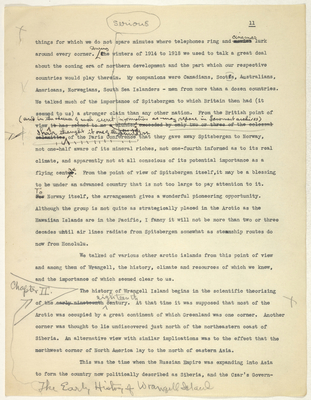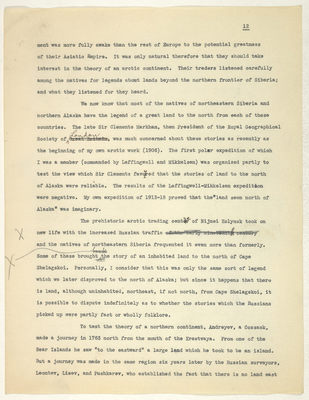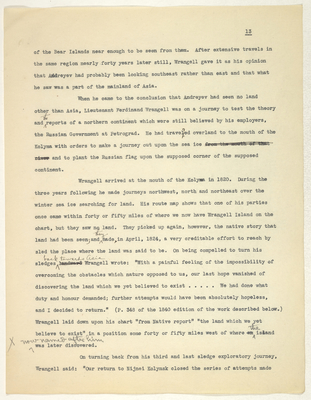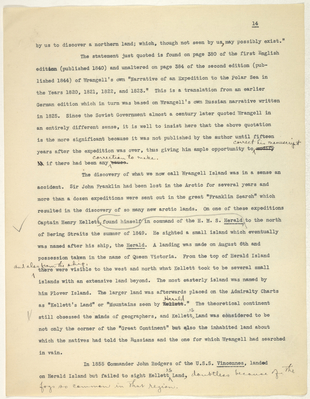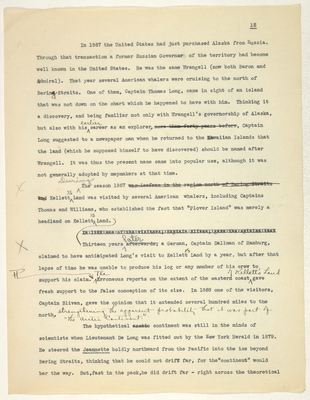Pages
stefansson-wrangel-09-26-001-016
Things for which we do not spare minutes where telephones ring and [cinemas] lurk around every corner. During the winters of 1914 to 1918 we used to talk a great deal about the coming era of northern development and the part which our respective countries would play therein. My companions were Canadians, Scots, Australians, Americans, Norwegians, South Sea Islanders - men from more than a dozen countries. We talked much of the importance of Spitsbergen to which Britain then had (it seemed to us) a stronger claim than any other nation. From the British point of view (and in the [?] of such secret informationas may [?] in Government archives) [should?] thought it one of the blunders of the Paris Conference that they gave away Spitsbergen to Norwar, not one-half aware of its mineral riches, not one-fourth informed as to its real climate, and apparently not at all conscious of its potential importance as a flying centre. From the point of view of Spitsbergen itself, it may be a blessing to be under an advanced country that is not too large to pay attention to it. To Norway itself, the arrangement gives a wonderful pioneering opportunity. Although the group is not quite as strategically placed in the Arctic as the Hawaiian Islands are in the Pacific, I fancy it will not be more than two or three decades until air lines radiate from Spitsbergen somewhat as steamship routes do now from Honolulu.
We talked of various other arctic islands from the point of view and among them of Wrangell, the history, climate and resources of which we knew, and the importance of which seemed clear to us.
Chapter II The Early History of Wrangell Island The history of Wrangell Island begins in the scientific theorizing of the eighteenth century. At that time it was supposed that most of the Arctic was occupied by a great continent of which Greenland was one corner. Another corner was thought to lie undiscovered just north of the northeastern coast of Siberia. An alternative view with similar implications was to the effect that the northwest corner of North America lay to the north of eastern Asia.
This was the time when the Russian Empire was expaning into Asia to form the country now politically described as Siberia, and the Czar's Govern-
stefansson-wrangel-09-26-001-017
12
ment was more fully awake than the rest of Europe to the potential greatness of their Asiatic Empire. It was only natural therefore that they should take interest in the theory of an arctic continent. Their traders listened carefully among the natives for legends about lands beyond the northern frontier of Siberia; and what they listened for they heard.
We now know that most of the natives of northeastern Siberia and northern Alaska have the legend of a great land to the north from each of these countries. The late Sir Clements Markham, then President of the Royal Geographical Society of London was much concerned about these stories as recently as the beginning of my own arctic work (1906). The first polar expedition of which I was a member (commanded by Leffingwell and Mikkelsen) was organized partly to test the view which Sir Clements favoured that the stories of land to the north of Alaska were reliable. The results of the Leffingwell-Mikkelson expedition were negative, My own expedition of 1913-18 proved that the"land seen north of Alaska" was imaginary.
The prehistoric arctic trading center of Nijnei Kolymsk took on new life with the increased Russian traffic of the early nineteenth century and the natives of northeastern Siberia frequented it even more than formerly. Some of these brought the story of an inhabited land to the north of Cape Shelagskoi. Personally, I consider that this was only the same sort of legend which we later disproved to the north of Alaska; but since it happens that there is land, although uninhabited, northeast, if not north, from Cape Shelagskoi, it is possible to dispute indefinitely as to whether the stories which the Russians picked up were partly fact or wholly folklore.
To test the theory of a northern continent, Andreyev, a Cossack, made a journey in 1763 north from the mouth of the Krestvaya. From one of the Bear Islands he saw "to the eastward" a large land which he took to be an island. But a journey was made in the same region six years later by the Russian surveyors, Leontev, Lisev, and Pushkarev, who established the fact that there is no land east
stefansson-wrangel-09-26-001-018
13
of the Bear Islands near enough to be seen from them. After extensive travels in the same region nearly forty years later still, Wrangell gave it as his opinion that Andreyev had probably been looking southeast rather than east and that what he saw was a part of the mainland of Asia.
When he came to the conclusion that Andreyev had seen no land other than Asia, Lieutenant Ferdinand Wrangell was on a journey to test the theory and [the] reports of a northern continent which were still believed by his employers, the Russian Government at Petrograd. He had traveled overland to the mouth of the Kolyma with orders to make a journey out upon the sea ice from the mouth of that river and to plant the Russian flag upon the supposed corner of the supposed continent.
Wrangell arrived at the mouth of the Kolyma in 1820. Luring the three years following he made journeys northwest, north and northeast over the winter sea ice searching for land. His route map shows that one of his parties once came within forty or fifty miles of where we now have Wrangell Island on the chart, but they saw no land. They picked up again, however, the native story that land had been seen; and they made, in April, 1824, a very creditable effort to reach by sled the place where the land was said to be. On being compelled to turn his sledges back towards asia Wrangell wrote: "With a painful feeling of the impossibility of overcoming the obstacles which nature opposed to us, our last hope vanished of discovering the land which we yet believed to exist ..... We had done what duty and honour demanded; further attempts would have been absolutely hopeless, and I decided to return." (P. 348 of the 1840 edition of the work described below.) Wrangell laid down upon his chart "from native report" "the land which we yet believe to exist" in a position some forty or fifty miles west of an the island now named after him was later discovered.
On turning back from his third and last sledge exploratory journey, Wrangell said: "Our return to Nijnei Kolymsk closed the series of attempts made
stefansson-wrangel-09-26-001-019
14
by us to discover a northern land; which, though not seen by us, may possibly exist."
The statement just quoted is found on page 380 of the first English edition (published 1840) and unaltered on page 384 of the second edition (published 1844) of Wrangell's own “Narrative of an Expedition to the Polar Sea in the Years 1820, 1821, 1822, and 1823." This is a translation from an earlier German edition which in turn was based on Wrangell’s own Russian narrative written in 1825. Since the Soviet Government almost a century later quoted Wrangell in an entirely different sense, it is well to insist here that the above quotation is the more significant because it was not published by the author until fifteen years after the expedition was over, thus giving him ample opportunity to correct his manuscript if there had been any correction to make.
The discovery of what we now call Wrangell Island was in a sense an accident. Sir John Franklin had been lost in the Arctic for several years and more than a dozen expeditions were sent out in the great "Franklin Search" which resulted in the discovery of so many new arctic lands. On one of these expeditions Captain Henry Kellett, found himself in command of the H. M. S. Herald to the north of Bering Straits the summer of 1849. He sighted a small island which eventually was named after his ship, the Herald. A landing was made on August 6th and possession taken in the name of Queen Victoria. From the top of Herald Island and also from the ship, there were visible to the west and north what Kellett took to be several small islands with an extensive land beyond. The most easterly island was named by him Plover Island. The larger land was afterwards placed on the Admiralty Charts as "Kellett's Land" or "Mountains seen by Herald." The theoretical continent still obsessed the minds of geographers, and Kellett's Land was considered to be not only the corner of the "Great Continent" but also the inhabited land about which the natives had told the Russians and the one for which Wrangell had searched in vain.
In 1855 Commander John Rodgers of the U.S.S. Vincennes, landed on Herald Island but failed to sight Kellett's Land, doubtless because of the fogs so common in that region.
stefansson-wrangel-09-26-001-020
15 In 1867 the United States had just purchased Alaska from Russia. Through that transaction a former Russian Governor of the territory had become well known in the United States. He was the same Wrangell (now both Baron and Admiral). That year several American whalers were cruising to the north of Bering Straits. One of them, Captain Thomas Long, came in sight of an island that was not down on the chart which he happened to have with him. Thinking it a discovery, and being familiar not only with Wrangell's governorship of Alaska, but also with his earlier career as an explorer, more than forty years before, Captain Long suggested to a newspaper man when he returned to the Hawaiian Islands that the land (which he supposed himself to have discovered) should be named after Wrangell. It was thus the present name came into popular use, although it was not generally adopted by mapmakers at that time.
During the season 1867 was icefree in the region north of Bering Straits and Kellett's Land was visited by several American whalers, including Captains Thomas and Williams, who established the fact that "Plover Island" was merely a headland on Kellett's Land.
Thirteen years afterwards later a German, Captain Dallman of Hamburg, claimed to have anticipated Long's visit to Kellett's Land by a year, but after that lapse of time he was unable to produce his log or any member of his crew to, support his claim. The erroneous reports on the extent of the eastern coast of Kellett's Land gave fresh support to the false conception of its size. In 1869 one of the visitors, Captain Bliven, gave the opinion that it extended several hundred miles to the north, strengthening the apparent probability that it was part of "The Arctic Continent."
The hypothetical arctic continent was still in the minds of scientists when Lieutenant De Long was fitted out by the New York Herald in 1879. He steered the Jeannette boldly northward from the Pacific into the ice beyond Bering Straits, thinking that he could not drift far, for the "continent" would bar the way. But,fast in the pack,he did drift far - right across the theoretical
